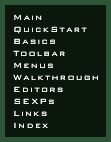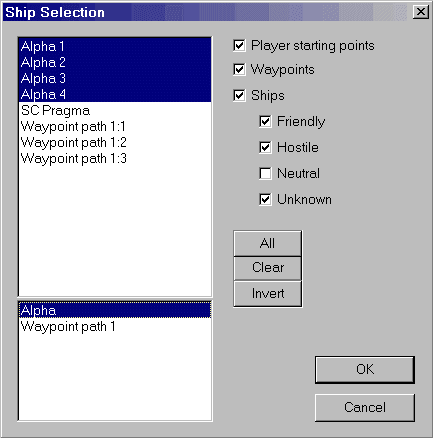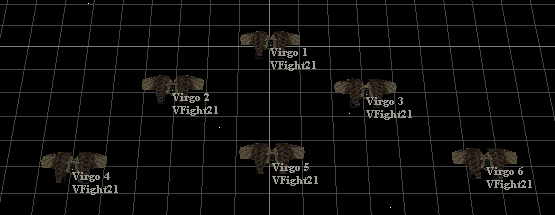 |
The Toolbar
|
| |
This file explains the row of controls near the top of the
screen. There are over a dozen, but don't worry about
memorizing them; holding the mouse pointer over any control for a
second or so will show the name and hotkey for that control.
The sections of this file are:
|
Mouse Drag Mode
|
| |

These three buttons determine what happens when you drag an object
with the mouse. Only one of them can be pressed at a time.
If the first button (Select) is pressed, dragging the mouse
has no effect. This is a good choice when you've got all of your
ships right where you want them, and don't want to accidentally move
something.
The second button (Select and Move) is pressed by default.
This lets you move objects by dragging them with the mouse.
The third button (Select and Rotate) lets you rotate objects
without changing their position. The direction of rotation depends
on the Axis Constraints.
The speed of movement and rotation is controlled by the Speed Menu.
|
Rotate Locally
|
| |

This button determines what happens if you rotate several marked
objects. When it is not pressed, the entire group rotates, as if
they were connected to each other by invisible sticks. When it is
pressed, each object rotates without changing its position, sort of
like a marching band turning a corner.
The picture below shows three groups of GTC Fenrises. The group on
the left has been rotated non-locally, while the group on the
right has been rotated locally.

|
Axis Constraints
|
| |

FreeSpace 2 missions take place in three-dimensional space, but the
mouse can only control two dimensions at a time. These buttons
determine which dimensions objects move along when you drag them with
the mouse. For example, if X is pressed, you can drag a ship
along the X axis, but its Y and Z positions
will not change.
If you have the Mouse Drag Mode set to
Select and Rotate, the axis constraints refer to the axes
relative to the object in
question, not the normal location axes. Rotating around the X
axis is pitching up and down, rotating around the Y axis is yawing
left and right, and rotating around the Z axis is rolling
left and right.
|
Select List
|
| |

This button lets
you change which objects are marked. When you have dozens of
objects in your mission, this can be easier than marking things
with the mouse.
When pressed, this button pops up a dialog box. All objects in the
mission are listed in the upper left. Click on an object's name to
highlight it, and ctrl click to highlight additional objects.

You can filter out various
kinds of objects by unchecking the boxes in the upper right.
(Player Starting Points are ships flown by players.)
The All button highlights everying. Clear removes all
highlighting. Invert highlights all of the unhighlighted
objects, and vice versa.
The box in the lower left lists wings and waypoint paths. Click on one to
highlight all of the objects in that group.
Close the dialog box with Okay to mark the highlighted
objects (and unmark everything else), or Cancel to discard
your changes.
|
Selection Lock
|
| |

When this button is pressed, clicking with the mouse does not change
what is marked. Instead, it acts as if you dragged the currently marked
objects to the spot where you clicked.
|
Form / Disband Wing
|
| |

These buttons let you group ships (usually fighters) into wings, or
break up those wings.
The Form Wing button puts all of the marked ships into a
wing. It pops up a dialog box asking for the name of the new wing.
If some of the
marked ships are already in a wing, you will be given the
opportunity to reform that wing, that is, redefine it to consist of the
currently marked ships. When ships are grouped into a wing, their
names are changed to reflect this.
Disband Wing breaks up the marked wing. The ships remain
where they are.
You can put as many as six ships in a wing. If a fighter or bomber
wing is going to show up in the player's HUD, it can have at most
four ships.
The HUD wingmen status guage only supports Alpha, Beta, Gamma,
Delta, and Epsilon wings. For a single-player mission, the player
must be Alpha 1. You can't have a Gamma wing without a Beta wing,
and none of the first three can be reinforcements.
For cooperative multiplayer missions, the players
must be in Alpha, Beta, and Gamma wings. For team vs. team
multiplayer missions, the players must be in Alpha and Zeta wings.
Ships in a wing want to stay together, and want to be in particular
positions within the wing. If you place them differently, they may
crash into each other while maneuvering into place at the beginning
of the mission. The picture
below shows the standard positions of the ships within a wing.

Standard wing names are:
| Friendly |
Enemy |
Alpha
Beta
Gamma
Delta
Epsilon
Zeta
Eta
Theta
Iota
Kappa
Lambda
Mu
|
Nu
Xi
Omicron
Pi
Rho
Sigma
Tau
Upsilon
Phi
Chi
Psi
Omega
|
Cancer
Leo
Virgo
Libra
Scorpio
Sagittarius
Capricorn
Aquarius
Pisces
Aries
Taurus
Gemini
|
|
Zoom
|
| |

These buttons let you zoom in or out to see just the things you
want. Of course, you can also move the camera manually.
Zoom Selected moves the camera forward or back so that the
marked objects are all visible.
Zoom Extents moves the camera forward or back so that all
objects in the mission are visible.
|
Show Distances
|
| |

When this button is pressed, you will see the distances between
marked objects, as in the picture below.

|
Rotate Around Object
|
| |

When this button is pressed, the currently selected object is
centered. The Camera Movement
Keys now act differently: keypad 4
and 6 move left and right in a circle around the object, keypad 2
and 8 move up and down in a circle around the object, and A and Z
move toward and away from the object. The other camera movement
keys don't do anything in this mode.
If nothing is selected, this button has no effect.
|
Selection Box
|
| |

The last control on the Toolbar, and probably the most
useful, is the Selection Box. Clicking on the triangle at
the right side pops up a menu from which you can select any of the
ship types in FreeSpace 2, as well as waypoints, jump nodes, and lone
asteroids. (If you want an asteroid field, use the Asteroid
Field Editor.) The selected object type will be created when
you ctrl click with the mouse in the main area of the FRED2 window.
If you have a waypoint selected when you place a new waypoint, the new
one will be added to the same path (right after the selected one).
Otherwise, the new waypoint will be in a new path.
Lone asteroids aren't terribly useful; ships and weapons fly right
through them.
The prefixes for the different ship classes generally indicate the government
that originally produced that class and the ship type.
For example, something with the prefix GTSG is a Galactic
Terran Sentry Gun.
| Abbr. |
Government |
| GT |
Galactic Terran |
| GTV |
Galactic Terran-Vasudan |
| GV |
Galactic Vasudan |
| NT |
Neo-Terran |
| PV |
Parliamentary Vasudan |
| S |
Shivan |
| T |
Terran |
| V |
Vasudan |
| Abbr. |
Class |
| F |
Fighter |
| B |
Bomber |
| C |
Cruiser or Container |
| Cv |
Corvette |
| D |
Destroyer |
| J |
Juggernaut |
| A |
AWACS (Advanced Warning And Control System) |
| AC |
Armored Container |
| DR |
Drone |
| EP |
Escape Pod |
| Fr |
Freighter |
| G |
Gas miner |
| I |
Installation |
| M |
Medical ship |
| NB |
Nav Bouy |
| S |
Support ship |
| SC |
Science Cruiser or Standard Container |
| SG |
Sentry Gun |
| T |
Transport |
| TC |
Tech Container |
You can learn more about the different ship classes in the Tech Room
within FreeSpace 2.
|
|


